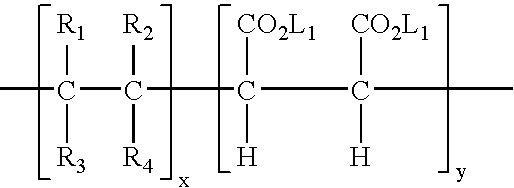Warewashing system containing low levels of surfactant
a surfactant and warewashing technology, which is applied in the direction of surface-active detergent compositions, cleaning processes and utensils, detergent compositions, etc., can solve the problems of inability long washing time and rinsing time, and the concept of built-in rinse components is not expected to work in institutional warewashing processes, etc., to achieve faster drying of substrates and reduce the thickness of the rinsewater film
- Summary
- Abstract
- Description
- Claims
- Application Information
AI Technical Summary
Benefits of technology
Problems solved by technology
Method used
Image
Examples
example 1
[0130] In this example the drying behaviour of various substrates is tested in an institutional single tank warewash machine. A standard institutional wash process is applied for this test with a main wash process containing alkalinity, phosphate and hypochlorite. First (test 1A) the drying behaviour of this process with a standard rinse process is determined. In this standard rinse process a rinse aid is dosed in the separate rinse.
[0131] Then (test 1B) the drying behaviour is determined for a wash process in which no rinse components are present (not dosed via the separate rinse and not added to the main wash process).
[0132] Then (tests 1 C up to 1 G) the drying behaviour is determined for various wash processes in which no rinse component is dosed in the separate rinsed (so rinsed only with fresh water) but where different type of surfactants (or mixtures) are added to the main wash together with the other main wash components. These surfactants are:
[0133] Adekanol B2020 (test...
example 2
[0171] The warewasher used for these test series is an Electrolux Wash Tech 60 single tank machine. Specifications single tank hood machine (for example 2):
Type: Electrolux Wash Tech 60
Volume washbath: 40 L
Volume rinse: 4 L
Wash time: 60 seconds
Rinse time: 8 seconds
Wash temperature: 55-65° C.
Rinse temperature: 80-90° C.
[0172] Process
[0173] When the wash bath is filled with soft water and heated up, the wash program is started. The water will be circulated in the machine by the internal wash pump and by the wash arms over the dishware. When the wash time is over, the wash pump will stop. Then the rinse program will start, fresh warm water from the boiler (directly connected to a tap) will be rinsed by the rinse arms over the dishware. The rinse water will flow partly direct into the drain by an overflow pipe, the other part will flow into the wash bath. When the rinse time is over the machine is opened.
[0174] It should be noticed that also in this example only fresh w...
example 3
[0187] The same machine and test conditions are used as described in example 2, but now attention is paid to visual appearance of the substrates after the drying process. The substrates are assessed visually with a score in the range from 1 (is very poor) to 5 (is very good) on the following aspects:
[0188] A. Filming: here drying pattern and formation of visual layer on the substrate s is evaluated; 1=unequal drying with visual layer on substrates; 5=equal drying and no visual layer on substrate.
[0189] B. Spotting: formation of droplets and stripes are evaluated after drying; 1=many drops and stripes; 5=perfectly dried with no drops and stripes.
[0190] By this evaluation of the visual appearance, the areas in contact with the rack, the edge of the plates, and the inside of the glasses and the cups are not considered. The wash cycle is repeated and the visual appearance assessments is done a second time with the same substrates and without adding any chemicals and the average value...
PUM
 Login to View More
Login to View More Abstract
Description
Claims
Application Information
 Login to View More
Login to View More - R&D
- Intellectual Property
- Life Sciences
- Materials
- Tech Scout
- Unparalleled Data Quality
- Higher Quality Content
- 60% Fewer Hallucinations
Browse by: Latest US Patents, China's latest patents, Technical Efficacy Thesaurus, Application Domain, Technology Topic, Popular Technical Reports.
© 2025 PatSnap. All rights reserved.Legal|Privacy policy|Modern Slavery Act Transparency Statement|Sitemap|About US| Contact US: help@patsnap.com



